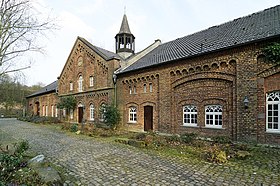Museum of the City of Lünen
 Museum of the City of Lünen |
|
| Data | |
|---|---|
| place | Luenen |
| operator |
City of Lünen
|
| management |
Katja Stromberg
|
| Website | |
| ISIL | DE-MUS-089716 |
The Museum of the City of Lünen , which has existed since 1966, is located in the servants' house of Schwansbell Castle in Lünen ( Unna district , North Rhine-Westphalia ). It belongs to the route of industrial culture - brine, steam and coal .
The holdings of the Museum of the City of Lünen have been on display in the former farm building of Schwansbell Castle since 1983. On more than 500 square meters, the collected collections are presented to the visitor. The focus is on five living rooms from the period between 1840 and 1930, a cast iron collection, the toy and doll collection, a ceramics department as well as rural and handicraft tools.
collection
Living from 1840 to 1930
There are currently four living rooms and one bedroom on display in the home decor department. The oldest facility dates from 1840/50 and once belonged to the Waldschmidt family , from whose possession it was donated to the museum. Three rooms around 1900 stand side by side: the living room of a civil servant family from Lünen and the kitchen-cum-living room of a working-class family from Lünen-Süd. The rooms are almost at the same time in their facilities and thus enable comparisons of living culture. The youngest room is a gentleman's room that was manufactured in 1930 by a furniture factory in Hamm for a family from Lüner. The equipment includes memorabilia from German East Africa . The owner was a colonial administrator there.
Cast iron and stoves
The “Cast Iron” department reminds us that there were once four iron foundries in the city of Lünen that produced a wide range of cast iron products. The stove collection is particularly striking here, mainly from the 19th and 20th centuries. Room ovens, stoves and workshop ovens, but also emergency ovens, such as B. Trench ovens document the development of the iron oven. The iron art casting, especially the second half of the 19th century, is shown in many examples, as well as the products of the ironworks for everyday use, e.g. B. iron.
Toys and dolls
The colorful and amiable world of toys complements the home decor department, because dollhouses and toys are miniaturized images of the adult world and reflect social models and educational ideas - the toys were "learning" toys. In addition to the fascination that emanates from old toys and dolls made of wood, wax, leather, fabric, porcelain or plastic, the collection provides an insight into the social reality of the doll makers: Child labor was common in doll production until the 20th century.
Ceramics (focus on pottery)
The “ceramics” department goes back to a trade that used to flourish in Lünen: pottery. In the 19th century there were about ten companies here that sold their products within a radius of 50 km. In addition to products from Lüner, goods from other Westphalian pottery locations will also be presented, as well as imported goods brought to Westphalia from the Hessian, Lower Rhine and even from the Lower Silesian Bunzlau pottery area . A small porcelain cabinet, the pieces of which are part of the Waldschmidt donation, rounds off the ceramics department.
From flails to butter churns
The museum building, which once served as a stable and barn for the agriculture of Schwansbell Castle, offers space on its upper floor for a collection of agricultural and handicraft tools. In the hall-like room, field devices are set up with which farmers in Lünen and the surrounding area did their work. Tools from the rural kitchen and devices for spinning and weaving give an insight into the work of women. A tailor's workshop, a bakery, a wooden shoemaker's shop and a shoemaker's workshop complete the picture.
Others
Group visits are also possible during opening hours. The museum publishes information from the museum about museum objects and the history of the city of Lüner. The museum also organizes changing exhibitions.
Civil weddings are also possible in two rooms of the museum upon consultation with the city.
Katja Stromberg has been the new director of the museum since 2018. She is the successor to Wingolf Lehnemann, who built the museum and ran it on a voluntary basis for over 50 years.
Entry to the museum is free.
Web links
Individual evidence
- ↑ Museum management. Retrieved February 15, 2020 .
Coordinates: 51 ° 36 ′ 13.1 ″ N , 7 ° 32 ′ 19 ″ E